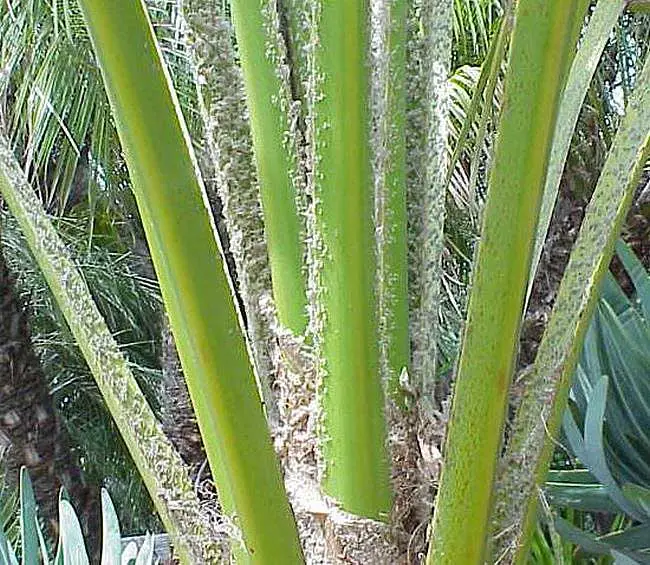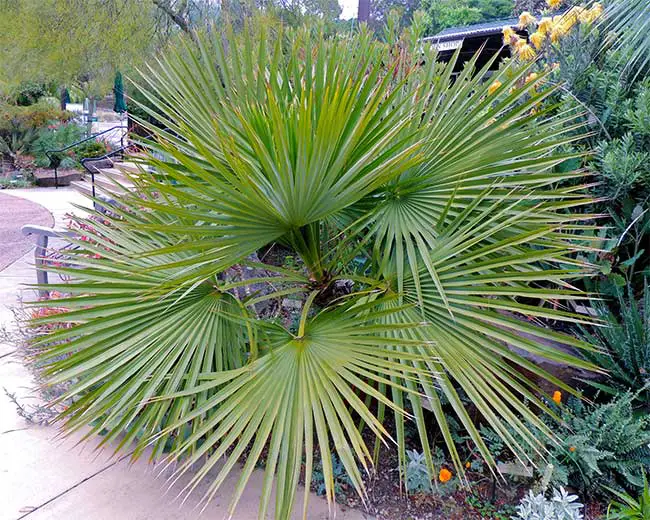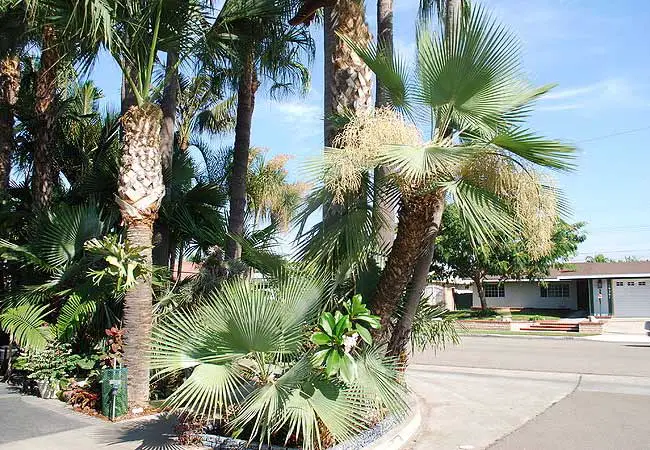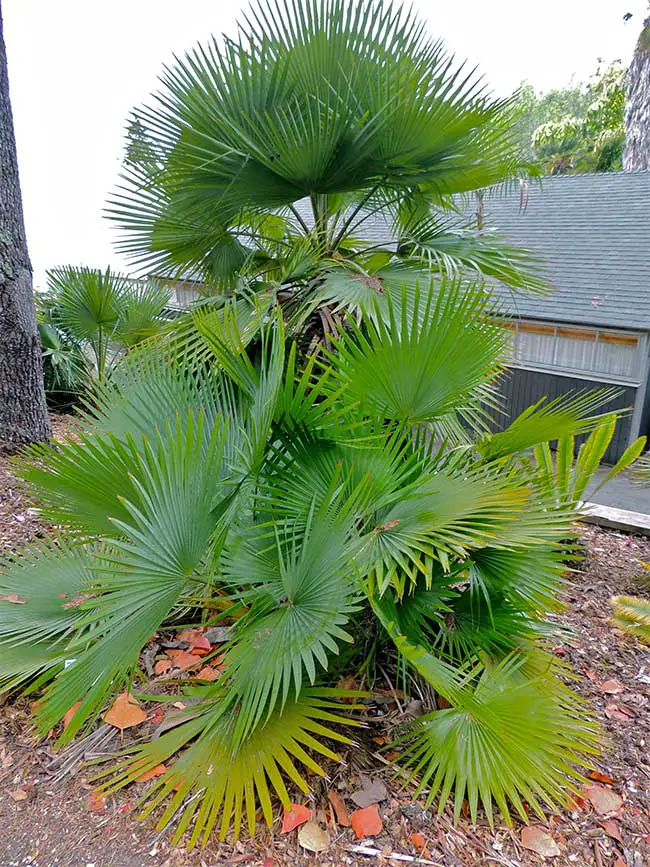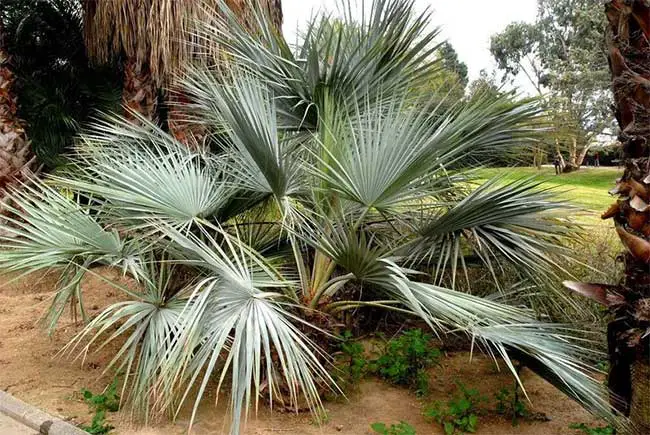
Brahea dulcis, commonly referred to as the Rock Palm or Sombrero Palm, is a captivating palm species native to Mexico. It is celebrated for its unique appearance and versatility in landscaping.
This palm typically reaches a height of 20 to 40 feet (6 to 12 meters) and displays a stout and solitary trunk. The trunk has a distinctive grayish-brown color and is covered with the remnants of old fronds, giving it a textured appearance.
One notable feature of this palm is its relatively slow growth rate, making it suitable for those seeking a long-term landscaping addition.
Brahea dulcis is resilient and can adapt to various soil types and light conditions, including full sun or partial shade. It is also known for its drought tolerance once established.
Quick Facts:
| Scientific name: | Brahea dulcis |
| Common names: | Sombrero Palm, Desert Palm, Rock Palm, Fiona Palm |
| Origin: | Native to Mexico. |
| Growth Rate: | Moderate. Up to 20-40ft tall and 10-15ft wide. |
| Cold Tolerance: | USDA Zones 9a (20 to 25 F) to 11 (above 40 F). |
| Light Req: | Moderate, high |
| Water Req: | Moderate |
| Soil Req: | Widely adaptable |
| Fruit: | Green to purple. Not edible. |
| Propagation: | Through seeds. |
Sombrero Palm Appearance
The Brahea dulcis’s combination of a stout trunk, large fan-shaped fronds, textured trunk surface, and adaptability makes it a captivating addition to gardens and landscapes, particularly in regions with a suitable climate for its growth.
This palm has a relatively slow growth rate, which means that significant changes in size can take several years to become noticeable.
This palm typically features a stout, solitary trunk that can reach heights of 20 to 40 feet (6 to 12 meters). The trunk has a striking grayish-brown coloration and is adorned with the remnants of old fronds, creating a textured and rugged appearance.
The fronds of Brahea dulcis are fan-shaped and relatively large, ranging from 4 to 6 feet (1.2 to 1.8 meters) in length. They are typically deep green in color, adding a lush and tropical element to the palm’s overall look.
Flowers and Fruits of the Sombrero Palm
The Sombrero Palm produces small and relatively inconspicuous flowers. These flowers typically have a cream or yellowish color and are arranged in clusters, although they are not particularly showy or fragrant.
These flowers play an essential role in the palm’s reproductive process by attracting pollinators, such as insects.
In terms of fruit, the Rock Palm generates small and spherical fruits that start off green and gradually ripen to a dark purple or black color. Each fruit is usually less than an inch (2.5 centimeters) in diameter.
While these fruits are not typically consumed by humans, they serve as an essential food source for various wildlife species in the palm’s native habitat.
How to Care for the Sombrero Palm
These palms are known for their adaptability to various soil types and light conditions, thriving equally well in full sun or partial shade. Thus, selecting a location in your garden that suits their preferences is the first step in their care.
When it comes to watering, particularly during their early years, they benefit from consistent moisture to establish strong root systems. As they mature, they become more drought-tolerant, but it’s still essential to provide occasional watering, especially in dry periods.
Pruning requirements for the Rock Palm are generally minimal, primarily involving the removal of dead or damaged fronds. This helps maintain their natural grace without over-manipulation.
These palms are known for their relatively slow growth rate, which means they don’t require frequent fertilization. Applying a balanced, slow-release palm fertilizer once or twice a year during the growing season is typically sufficient to provide the necessary nutrients.
While it is native to regions with warm and temperate climates, it can tolerate occasional cold spells and light frosts.
Generally, this palm is considered suitable for USDA hardiness zones 9a to 11b. In these zones, which include parts of California, Arizona, Texas, Florida, and similar regions, the Rock Palm can thrive and survive mild winter conditions without significant damage.
However, it’s essential to note that its cold tolerance has limits. In regions with severe and prolonged freezing temperatures, especially below 20°F (-6.7°C), protecting the palm during cold snaps is advisable, particularly for younger palms or those in less temperate climates.
While they are generally pest-resistant, it’s wise to keep an eye out for common issues like scale and mites. Regular inspections help detect and address any pest-related concerns promptly.
Sombrero Palm Pictures
